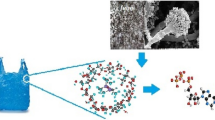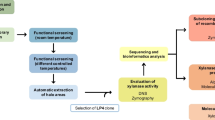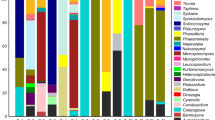Abstract
The yeast-like fungus Coniochaeta pulveracea was studied with regard to its novel lignocellulolytic activities and the possible effect thereof on yeasts from the woody phylloplane. An enrichment procedure was used to isolate C. pulveracea from a decaying Acacia tree, and the identity of the isolate was confirmed using morphology, as well as molecular and phylogenetic techniques. This isolate, as well as strains representing C. pulveracea from different geographical regions, were compared with regard to optimum growth temperature and enzyme activity to representatives of closely related species. These include strains of Coniochaeta boothii, Coniochaeta rhopalochaeta, and Coniochaeta subcorticalis. Plate assays for cellulase and xylanase activity indicated that all representatives of the above-mentioned species were able to produce extracellular hydrolytic enzymes and were also able to degrade birchwood toothpicks during a 50-day incubation period at 30°C. To test the ability of these fungi and their enzymes to release simple sugars from complex cellulosic substrates, filtrates obtained from liquid cultures of Coniochaeta, cultivated on carboxymethyl cellulose (CMC) as sole carbon source, were analyzed using high-performance liquid chromatography analysis. Consequently, the presence of mono- and disaccharides such as glucose and cellobiose was confirmed in these culture filtrates. Two subsequent experiments were conducted to determine whether these simple sugars released from woody material by Coniochaeta may enhance growth of phylloplane yeasts. In the first experiment, representatives of Coniochaeta were co-cultured with selected yeasts suspended in agar plates containing birchwood toothpicks, followed by examination of plates for colony formation. Results indicated that Coniochaeta growth on the toothpicks enhanced growth of nearby yeast colonies in the agar plates. In the second experiment, representatives of selected yeasts and Coniochaeta species were co-cultured on CMC and xylan-containing plates where after yeast colony formation was recorded on the plates. Saccharomyces cerevisiae strains, engineered to utilize specific wood degradation products, i.e., cellobiose or xylose, as sole carbon source were used as positive controls. While it was found that cellobiose released from CMC was assimilated by the yeasts, no evidence could be obtained that xylose released from xylan was used as carbon source by the yeasts. These ambiguous results could be ascribed to secretion of nutritious metabolic end products, other than the products of fungal xylanases.




Similar content being viewed by others
References
Sánchez C (2009) Lignocellulosic residues: biodegradation and bioconversion by fungi. Biotechnol Adv 27:185–194
Hammel KE (1997) Fungal degradation of lignin. In: Cadisch G, Giller KE (eds) Plant litter quality and decomposition. CAB-International, pp 33–46
Christov LP, Prior BA (1996) Repeated treatments with Aureobasidium pullulans hemicellulases and alkali enhance biobleaching of sulphite pulps. Enzyme Microb Technol 18:244–250
Lopez MJ, del Carmen Vargas-García M, Suárez-Estrella F, Nichols NN, Dien BS, Moreno J (2007) Lignocellulose-degrading enzymes produced by the ascomycetes Coniochaeta ligniaria and related species: application for a lignocellulosic substrate treatment. Enzyme Microb Technol 40:794–800
Weber E (2002) The Lecythophora–Coniochaeta complex I. Morphological studies on Lecythophora species isolated from Picea abies. Nova Hedwigia 74:159–185
Checa J, Barrasa JM, Moreno G, Fort F, Guarro J (1988) The genus Coniochaeta (Sacc.) Cooke (Coniochaetaceae, Ascomycotina) in Spain. Cryptogamie Mycol 9:1–34
Mahoney DP, LaFavre JS (1981) Coniochaeta extramundane, with a synopsis of other Coniochaeta species. Mycologia 73:931–952
Botha A (2006) Yeasts in soil. In: Rosa C, Peter G (eds) Biodiversity and ecophysiology of yeasts. Springer, Germany, pp 221–240
Munk A (1948) Pyrenomycetes collected in the peninsula Mols, Jutland. Dansk Bot Ark 12:1–19
Romero AI, Carmarán CC, Lorenzo LE (1999) A new species of Coniochaeta with a key to the species known in Argentina. Mycol Res 6:689–695
García D, Stchigel AM, Cano J, Calduch M, Hawksworth DL, Guarro J (2006) Molecular phylogeny of Coniochaetales. Mycol Res 110:1271–1289
Fonseca Á, Inácio J (2006) Phylloplane yeasts, chapter 13. In: Rosa CA, Péter G (eds) The Yeast Handbook; Biodiversity and Ecophysiology of Yeasts. Springer-Verlag, Berlin, Heidelberg, 263–301. ISBN 10-3-540-26100-1
Van Heerden A, Le Roux NJ, Swart J, Gardner-Lubbe S, Botha A (2008) Assessment of wood degradation by Pycnoporus sanguineus when co-cultured with selected fungi. World J Microbiol Biotechnol 24:2489–2497
Biely P, Krátký Z, Kocková-Kratochvílová A, Bauer Š (1978) Xylan-degrading activity in yeasts: growth on xylose, xylan and hemicellulose. Folia Microbiol 23:366–371
Biely P, Kremnický L (1998) Yeasts and their enzyme systems degrading cellulose, hemicelluloses and pectin. Food Technol Biotechnol 36(4):305–312
Laitila A, Wilhelmson A, Kotaviita E, Olkku J, Home S, Juvonen R (2006) Yeasts in an industrial malting ecosystem. J Ind Microbiol Biotechnol 33:953–966
Yarrow D (1998) Methods for the isolation, maintenance and identification of yeasts. In: Kurtzman CP, Fell JW (eds) The yeasts a taxonomic study, 4th edn. Elsevier, Amsterdam. ISBN 0-444-81312-8
Weber E, Görke G, Begerow D (2002) The Lecythophora–Coniochaeta complex II. Molecular studies based on sequences of the large subunit of ribosomal DNA. Nova Hedwigia 74:187–200
St Leger RJ, Joshi L, Roberts D (1998) Ambient pH is a major determinant in the expression of cuticle-degrading enzymes and hydrophobin by Metarhizium anisopliae. Appl Eviron Microbiol 64:709–713
Farkaš VM, Lišková M, Biely P (1985) Novel media for detection of microbial producers of cellulase and xylanase. FEMS Microbiol Lett 28:137–140
Watanabe T, Watanabe Y, Nakamura K (2003) Biodegradation of wood in dual cultures of selected two fungi determined by chopstick method. J Biosci Bioeng 95:623–626
Van der Westhuizen GCA, Eicker A (1994) Mushrooms of Southern Africa. Cape Town, Struik Publishers (Pty) Ltd 2nd edition
Wadekar RV, North MJ, Watkinson SC (1995) Proteolytic activities in two wood-decaying basidiomycete fungi, Serpula lacrymans and Coriolus versicolor. Microbiol 141:1575–1583
Den Haan R, Rose SH, Lynd LR, van Zyl WH (2007) Hydrolysis and fermentation of amorphous cellulose by recombinant Saccharomyces cerevisiae. Metab Eng 9:87–94
Giuliano C, Khan AW (1984) Cellulase and sugar formation by Bacteroides cellulosolvens, a newly isolated cellulolytic anaerobe. Appl Environ Microbiol 48:446–448
Shary S, Ralph SA, Hammel KE (2007) New insights into the ligninolytic capability of a wood decay ascomycetes. Appl Environ Microbiol 73:6691–6694
Eriksson K-E, Grünewald A, Vallander L (1980) Studies of growth conditions in wood for three white-rot fungi and their cellulaseless mutants. Biotechnol Bioeng 22:363–376
Oriaran TP, Labosky P Jr, Royse DJ (1989) Lignin degradation capabilities of Pleurotus ostreatus, Lentinula edodes and Phanerochaeta chrysosporium. Wood Fibre Sci 21(2):183–192
Kurtzman CP, Fell JW (1998) The yeasts a taxonomic study, 4th edn. Elsevier, Amsterdam
De Villiers GK (2006) Development of recombinant Saccharomyces cerevisiae for improved d-xylose utilisation. PhD Thesis. Stellenbosch University, South Africa
Van Rooyen R (2007) Genetic engineering of the yeast Saccharomyces cerevisiae to ferment cellobiose. PhD. Thesis. Stellenbosch University, South Africa
Lynd LR, Weimer PJ, Van Zyl WH, Pretorius IS (2002) Microbial cellulose utilization: fundamentals and biotechnology. Microbiol Mol Biol Rev 66:506–577
Botes A, Boekhout T, Hagen F, Vismer H, Swart J, Botha A (2009) Growth and mating of Cryptococcus neoformans var. grubii on woody debris. Microb Ecol 57:757–765
Asgari B, Rasoul Z, Gams W (2007) Coniochaeta ershadii, a new species from Iran, and a key to well-documented Coniochaeta species. Nova Hedwigia 84:175–187
Uffen RL (1997) Xylan degradation: a glimpse at microbial diversity. J Ind Microbiol Biotechnol 9:1–6
Author information
Authors and Affiliations
Corresponding author
Rights and permissions
About this article
Cite this article
van Heerden, A., van Zyl, W.H., Cruywagen, C.W. et al. The Lignicolous Fungus Coniochaeta pulveracea and Its Interactions with Syntrophic Yeasts from the Woody Phylloplane. Microb Ecol 62, 609–619 (2011). https://doi.org/10.1007/s00248-011-9869-9
Received:
Accepted:
Published:
Issue Date:
DOI: https://doi.org/10.1007/s00248-011-9869-9




